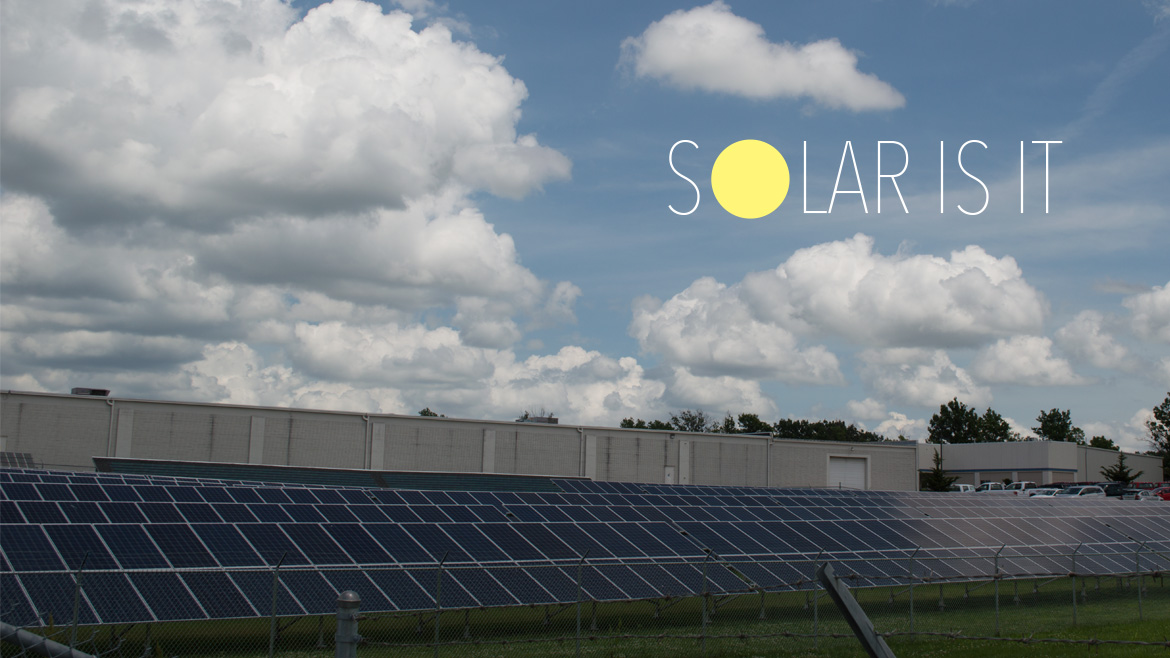Renewable Energy: Solar Is It

Joleen Pfefer’s home sits under the shade of Missouri trees, unlike the vegetable garden on the side of her home. It gets great sun exposure — 96 percent sun exposure in fact, a narrow tree in her neighbor’s yard preventing a perfect 100. This exposure is important for the solar panel array that sits in her garden and powers her home, installed by Dan Shifley of Dogwood Solar.
Dogwood Solar installs and services solar panels, skylights, and sun tunnels, which capture sunlight through the roof and carry it through tubular shafts into the home. They also install and service solar electric systems and solar water heaters.
“The interest and the installations grow every month,” Shifley says.
Dogwood serves residential clients and local businesses. With a 55 percent increase in the rated capacity of customer photovoltaic system (i.e. solar power) installment in 2015, Columbia as a whole is increasing its interest in solar power, with one big reason to hesitate: the price tag. A home solar system, without counting local or federal incentives, which can knock the price down, can cost more $30,000.
However, Shifley says the long-term benefits of solar vastly outweigh the cost of the technology. Coal, gas, and oil are environmentally costly in the long run, while today’s sunlight is free, or at least shines free from the sky.
“You don’t have to burn anything to pay for it,” he says, adding, “We’re not seeing any new coal plants, right? Solar is it.”
Columbia’s solar energy set-up utilizes net metering — when a customer produces more energy than they use, that energy goes back into the grid, and the customer gets a credit for it.
Connie Kacprowicz, communications director of Columbia’s Water and Light Department, says that Columbia’s reimbursement for excess production goes beyond the state’s required reimbursement for net metering.
Columbia’s renewable energy portfolio requires five percent of our energy to come from renewable sources. Currently, about seven percent of our city’s energy does, .08 percent of that energy coming from solar. The portfolio requires 15 percent renewable energy by the end of 2017, 25 percent by the end of 2022, and 30 percent by the end of 2030.
With that, there is a cost cap, so any increase in renewable energy can’t cause electric rates to increase by more than three percent above what they would be with non-renewable energy.
Columbia’s current solar projects are the West Ash Solar Field and Solar One, a program where solar systems are installed on city-owned land or businesses with good sun exposure, such as Bright City Lights and Quaker Oats. After the business installs the system, the city begins purchasing the energy through a power purchase agreement. These installments are paid for by customers who wish to invest in local solar energy projects.
The city offers rebates of $500 per kilowatt, up to 10 kilowatts, for qualifying systems. The city also offers loans to spread the cost of solar panels over time.
The Boone County Electric Cooperative is also building a solar farm, half an acre of 400 solar panels on Rangeline Street. Through their Community Solar program, supporters can buy energy from any number of panels. The panels will be installed by Dogwood Solar and will be ready for use by August.
In hopes to encourage the use of more solar, Columbia will be one of the first cities in Missouri (joining Gladstone and Raymore) to participate in SolSmart, a national program to reduce the cost and other barriers in the way of solar energy.
Columbia signed on as an early adopter of the program, and the city will turn in information in June to see if we qualify for further assistance from SolSmart. Barbara Buffaloe, the sustainability manager for Columbia, says that SolSmart helps initiate solar-friendly policies in city codes.
There are still issues to be addressed. Solar panels last about 25 years and require maintenance and replacement; every year, their maximum output decreases.
Buffaloe hopes to see solar opportunities increase for low-income houses. The city is looking to build more houses utilizing solar near Sexton and Garth.
The city would also like to see easier ways to store solar energy. Right now, peak solar production is around 2:00 in the afternoon, while peak energy demand is around 5:00 in the afternoon, when people are coming home from work to sit in their well-lit, air conditioned homes and watch television.
Kacprowicz anticipates that Columbia Water and Light will begin a community solar project that will allow renters and temporary residents of Columbia to harness solar energy by buying just a few kilowatts of energy produced from solar panels installed by the city. She would like to see more technologies, such as solar shingles, increase in prevalence and decrease in price.
“I think Columbia’s doing very well with encouraging solar, not only in the utility, but also in the residential,” Kacprowicz says.
On the installation side, Shifley would like to see a more streamlined way of submitting plans for installation to the developer. Right now, the process takes at least a week. By submitting the required paperwork (a site plan, one-line diagram, electric permit application, and interconnection agreement) online, Shifley thinks the work on both ends would be easier and more efficient. After all, efficiency is the name of the game.


